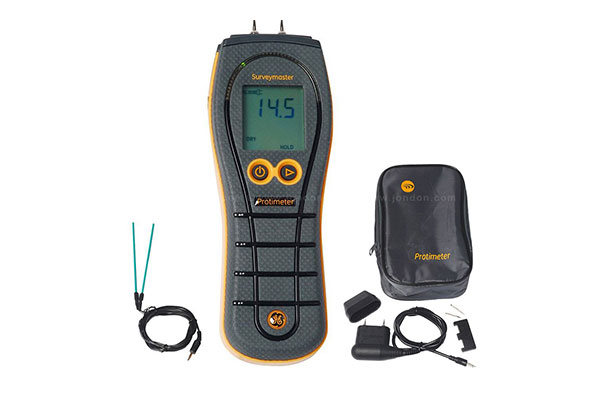The job of a water restoration professional is to transform your abnormally wet home as quickly and efficiently as possible back to its clean, pre-loss condition. The technician must begin by identifying any and all materials affected by the water. The two big questions that must be answered first are “What is wet?” and “How wet is it?” Having and using the right instruments and tools is the only way to satisfactorily answer these two questions. The right instruments and tools are the different types of moisture meters that are available.
After answering the “what” and “how wet”, there are two more important questions that come up during the drying process, “Is it drying?’ and “Is it done?” If you haven’t used any meters and logged the answers to the first two questions, you can’t possibly answer these last two.
Moisture Sensors
The most basic of moisture meters is the moisture sensor. Most moisture meters are used only on carpet, pad, and underlay to determine where any moisture may be and how far in may have traveled. In our years of experience, when a homeowner tells us “that water went to here”, we start checking with our moisture sensor just behind where they indicate. It just seems to work out that way. The water always to have moved a little bit further then they think. These sensors usually beep and flash a light when they sense moisture. The faster they beep and flash, the more moisture is present. They should only be used at the start of a job because organic salt deposits, like those found in pet urine, can cause these sensors to indicate moisture where there is none. Try explaining that to a homeowner. “My pet doesn’t do that,” or “We don’t even have a pet.” But maybe the previous owner did!
Thermal Imaging Cameras
These types of cameras detect differences in surface temperatures and then use color to represent cooler or warmer temperatures. Although cooler doesn’t necessarily mean wet, it indicates a good place to inspect further. We say this because an air leak, or missing insulation inside a wall cavity, may display the cooler colors, even when there may be no moisture present. Once an area is indicated as cooler, further testing should be done with a moisture meter. Other things that may “fool” a thermal imaging camera are heating and cooling ducts and reflective surfaces (some insulation has a shiny, reflective backing). These cameras are good at indicating areas of “potential” moisture.
Infrared Thermometers
Infrared thermometers use infrared light and are capable in reading surface temperatures without direct contact. Since water causes cooler surface temperatures and takes longer to return to what is “normal”, they can be used to find areas that may have been wet. This can be useful in situations where moisture has come from above and traveled down walls or across ceilings. Or when ceilings are too high to easily reach. They can be used to quickly determine the temperature coming out of HVAC ducts during the restoration process so you can see what affect the building’s heating or cooling may be having within the affected area. Just like the infrared cameras, infrared thermometers are a useful tool for finding areas that require further investigation.
Non-Penetrating Moisture Meters
These meters are noninvasive (they work without marring a surface) and will allow the technician to quickly locate wet materials. Depending on the style of meter, digital or dial, they can indicate an estimated percentage of moisture present in a material. Because they are not required to penetrate a surface they are great meters to use at the beginning of a job and to check drying as the work progresses. They are useful on vinyl floors, ceramic tile, concrete, wood, drywall, and almost any type of material. These meters do have some drawbacks concerning accuracy. They can be indicate false readings caused by:
Hydroxyl
- Metal corner bead on drywall walls
- Metal studs
- HVAC ducting
- Wall content in x-ray rooms
- Insulation with foil backings
- Metal plumbing
When using a non-penetrating meter it should always be held horizontal to the floor. This is because of the way the sensing pads are located on the meter. Non-penetrating meters usually have three different material settings, concrete or plaster, wood, and drywall. The technician must adjust the meter setting to the type of material it is being used on.
Penetrating Meters
Penetrating meters are the most accurate moisture meters and provide a true numerical value of a material. These meters have two pins that must be pushed or hammered into a material and operates on electrical resistance between the two pins. That electrical resistance is then converted by the meter into a quantitative value and displayed for the technician.
Penetrating meters usually come with different attachments that can be used in conjunction with them. Hammer probes have longer pins with electrical shielding on them can be attached and then in stages driven deeper into materials. Hardwood floors are one place that hammer probes are very useful. They allow the technician to accurately determine drying conditions as the pins are driven through the hardwood the wood and into the subfloor. Another commonly used attachment are thin “paddles” that can be slipped between a floor and a wooden sill plate.
These meters are similar to their non-penetrating cousins in that there are different settings for different materials to be checked. This is because different materials have different allowances of moisture content before being declared “wet”. Concrete can have 85% moisture content before being considered wet while wood is wet at or above 15% moisture content.
It is important to understand the limitations of each type of moisture meter. Many restorers start with non-penetrating meters to take a first look at damage and then employ the other types as work progresses. At Water Mold Fire Restoration our water damage technicians receive training on the use of every type of moisture meter. All of our team members have access to these meters for every job they perform. If your home is damaged by water, don’t guess about where and how the water has affected it, call us at 800-905-0277. We will come to your home within one hour of your call and inspect the damage and provide you with an estimate of the repairs required. Or if you choose, you can contact us by email at help@watermoldfire.net.








